Waterproofing a septic tank made of concrete rings: a review of materials + rules for implementation
Underground concrete structures need protection from the aggressive environment in which they have to work. Local treatment facilities are no exception, further exacerbated by the ability to harm the environment in the event of a leak. Agree, such a catastrophe, albeit of local importance, must be prevented.
Properly executed waterproofing of a septic tank made of concrete rings will prevent corrosion of the structure. Eliminates the possibility of direct communication of the contents with the surrounding soil. Water-repellent material will protect concrete and compounds used for processing joints from erosion.
The article introduces the types of waterproofing used to increase the stability of concrete. We described in detail the technology for the implementation of protection, assessed the effectiveness of the options. Photo selections and video training will help you get used to the topic faster.
The content of the article:
- Purpose and types of waterproofing septic tank
- Sprayable water barrier
- Lubricating compounds for septic tank protection
- Clay lock device
- Rolled waterproofing of a surface of a septic tank
- Stucco under pressure
- Penetrating or capillary waterproofing
- Materials for sealing inter-ring seams
- Conclusions and useful video on the topic
Purpose and types of waterproofing septic tank
In concrete, under the influence of moisture, leaching of lime is observed, which manifests itself as the appearance on the surface of stalactite rings and growths. The material is destroyed by magnesia salts contained in groundwater.
Reacting with lime, they create a compound that is well soluble in water - calcium sulfoaluminate, which water washes out of the concrete body, destroying it.
Carbon dioxide, also present in groundwater, triggers destructive processes in concrete by reacting with calcium oxide hydrate.
Water falling into microcracks and pores turns into ice when the temperature drops. An increase in its volume leads to fractures and large cracks in the already porous structure of the material. Biological corrosion of concrete is caused by microorganisms living in water.
Salt solutions, in contact with metal reinforcement located in the concrete body, cause electrochemical corrosion of steel. Due to its gradual destruction, the strength characteristics of the product are reduced, and then the design becomes completely unusable. Replacing concrete rings is fraught with many difficulties, and sometimes simply impossible.
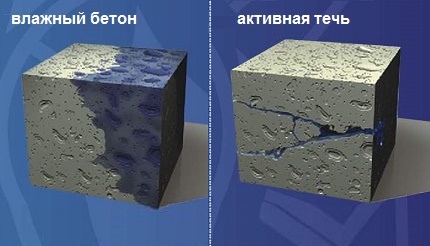
If you do not protect the septic tank from the effects of destructive factors, then dirty water will fall into the ground and infect it with microorganisms. An unpleasant smell will appear on the site, and representatives of the supervisory authorities will become your frequent guests.
All these reasons are enough to allocate funds and time to perform high-quality waterproofing of the septic tank, thereby avoiding problems with frequent and laborious repairs.
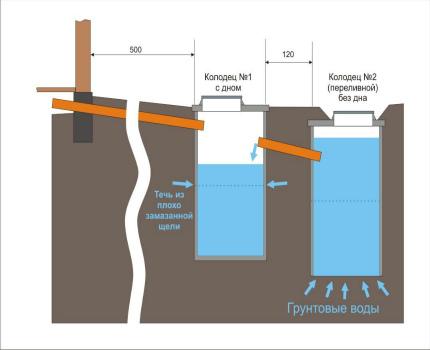
Particular attention should be paid to waterproofing the bottom of the first well at its junction with the lower ring. The base is concreted using a mesh as reinforcement.

To increase the strength of concrete rings on the outside and inside, there are many materials.
The most commonly used are:
- Sprayable compounds. Rings are processed by them from the outside using special equipment.
- Injection protection. It happens on an epoxy, mineral or polyurethane basis. For septic tanks it is used in extreme cases, since it is expensive.
- Coating compounds. Bituminous and bituminous. These are film-forming mixtures that, when applied in several layers, create a thin, water-impermeable layer.
- Rolled materials. They are used for gluing waterproofing.They are a stabilized bitumen or bitumen-polymer mastic applied to a fabric base from geotextile or fiberglass.
- Penetrating compounds. Insoluble crystalline hydrates are formed in the thickness of the concrete, creating a reliable hydrobarrier from the side of application to the penetration depth declared by the manufacturer.
A lot of different waterproofing materials enter the construction market, it’s not so easy to sort them out and choose the right one.
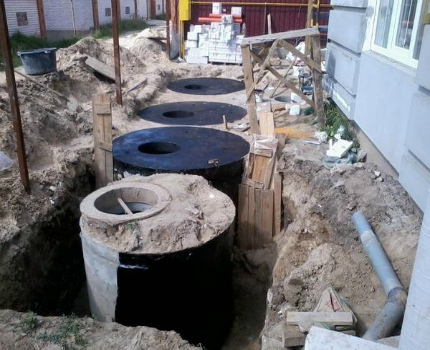
According to the criteria, durability and reliability, each type of waterproofing is different from each other. So, bitumen protection begins to crack after a few years, and mastic has a longer service life.
For more information about the options for waterproofing protection for sewer wells you find here.
Sprayable water barrier
This type of insulation allows you to create a monolithic seamless layer. Water-repellent emulsions are sprayed onto the surface of concrete rings under high pressure. The composition penetrates into splits, cracks, pores and completely fills them, blocking drains in a confined space.
The spraying composition contains a polymer composite, water and fillers such as talc, calcium carbonate, titanium dioxide, barium sulfate.
The use of waterproofing by spraying gives many advantages:
- Speed of execution.
- Excellent adhesion to the concrete surface.
- Quick freezing.
- Durability. Operated up to 20 years without loss of initial effectiveness.
- Resistance to fast temperature changes.
Sprayed waterproofing significantly improves the performance of the septic tank, thereby preventing the penetration of wastewater into the soil surrounding the structure.
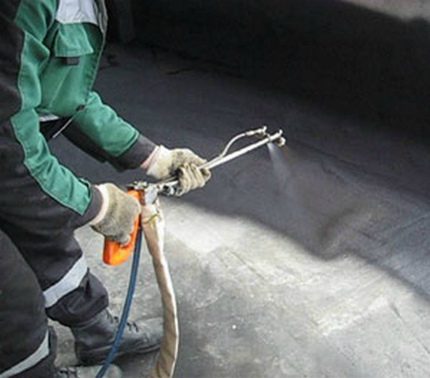
This type of waterproofing provides adhesion to the surface of concrete rings at the molecular level. It can be applied over the old layer by spraying. The main thing is to remove excess moisture from the surface before this.
Lubricating compounds for septic tank protection
Compared to other waterproofing technologies, the advantage of using coating materials is that they can be applied to surfaces with any geometry. No special apparatus and mechanisms are required.
Classification of water-repellent materials
There are 4 groups of coating compositions, characterized by a base, which is used as:
- bitumen;
- cement;
- polymers.
The 4th group includes mastics containing sealants. Regardless of the basis, coating waterproofing fills the slightest cracks, eliminates defects and makes the surface monolithic.
Some brands of bitumen-polymer mastics contain volatile toxic compounds. Sometimes they provoke disorders of the nervous system, lead to poisoning, therefore, you need to work only using protective equipment - a respirator, gloves, a special robe.

If groundwater is located at great depths, then reinforce the isolation of the lower septic tank ring. If they lie high, then the top of the structure must be strengthened.
Bitumen-polymer mastic contains polymer additives and latex, due to the presence of which the characteristics of the material change for the better. When applying it to the surface, an elastic, very durable layer is created that retains its qualities at low temperatures. But for the bitumen-polymer composition to work, it must be applied in several layers.
Mastic is relatively inexpensive, you can apply it yourself, and if leaks appear somewhere, then the layer is easy to restore.
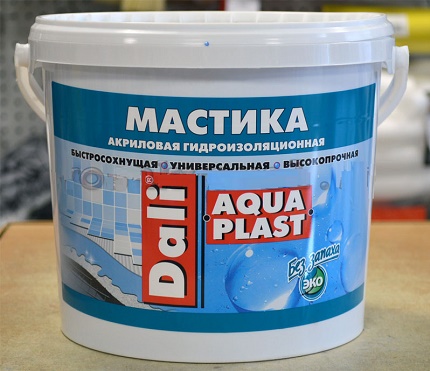
In addition, compared with other waterproofing technologies, the advantage of using coating materials is that they can be applied to surfaces with any geometry.
No special apparatus and mechanisms are required. There are mastic with a bitumen base and with additives in the form of polymers for cold and hot application.
The mastic for application by the hot method is first heated to 160 degrees C so that the bitumen passes into a plastic state. After they cover the surface of the concrete rings. Cold formulations are diluted with a solvent that evaporates after the insulation layer has solidified.
Mastics are single- and 2-component. Bitumen, a polymer is necessarily present in their composition, and additives that provide individual properties are different. Depending on the second component, the compositions are called: bitumen-latex, bitumen-rubber, bitumen-oil, bitumen-polyurethane.
Polyurethane and rubber make the material particularly flexible. The coating extends well without forming cracks. The rubber mixture is applied cold. It has antiseptic properties and high heat resistance.
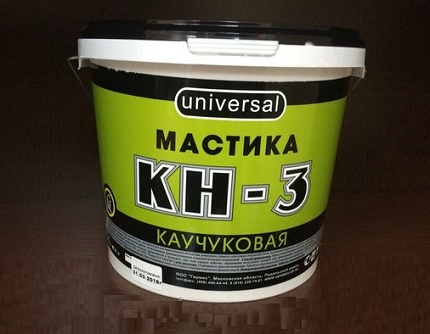
The surface coated with the mixture with oil ingredients does not harden. It is adhesive, well resists the aggressive influence of groundwater and soil, does not crack, and tolerates frosts up to -50 degrees C and high temperatures.
Rules for applying coating
Waterproofing is applied after sealing the inter-ring seams and places where the pipes go into the septic tank.
The process itself consists of 5 consecutive steps:
- Cleaning the surface from dirt, identifying defects, cracks and eliminating them using sealants or putty.
- Application of bitumen primer as a primer. It is first prepared according to the manufacturer’s instructions, then it is coated with a construction brush. Bitumen primer can be made by yourself, for which they take gasoline or engine oil, heat it and add crushed clean building bitumen. Stirring, the mixture continues to heat up to 200 degrees C, after which the primer is ready for use. Apply the first layer, and after it dries - the second.
- All is left for 24 hours. During this time, the primer will dry completely and its fine particles will penetrate deep into the concrete.
- Apply mastic with a construction brush, after thoroughly mixing the composition. If the mixture is too thick, it is diluted with any organic solvent. After completing the first layer, take time to dry it and repeat the procedure.
- Check the quality of the applied layer after it dries. If flaws are found, the surface is treated again and left for 2-3 days to dry.
Bituminous mastic is much cheaper than bituminous materials with polymer additives. It adheres well with concrete walls septic tankhas good water repellent characteristics, resistant to chemicals.
Bituminous mastic does not tolerate subzero temperatures, the coating becomes brittle, covered with microcracks. Enough such waterproofing for 5 years, a maximum of 7.
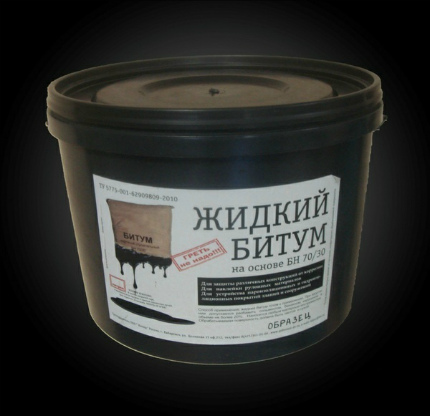
Some brands of bitumen-polymer mastics incorporate volatile toxic compounds. Sometimes they provoke disorders of the nervous system, lead to poisoning, therefore, you need to work only using protective equipment - a respirator, gloves, a special robe.
Clay lock device
A good result is the processing of the rings with bituminous mastic, followed by the installation of a clay castle. It is understood that the space between the concrete rings and the ground is filled with clay without any impurities. It is needed so that after melting snow or heavy rain water does not fall into the septic tank.
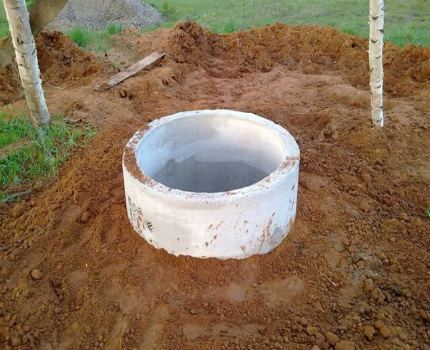
They do not recommend doing it right away, but after the soil settles and compacts. A castle made earlier will be destroyed by subsidence. Clay is covered in small layers, each time carefully tamped. Over the entire surface of the material should be adjacent. The slightest emptiness is not allowed, otherwise the work done will not give a result.
Rolled waterproofing of a surface of a septic tank
This type of material is used for waterproofing the outer surface of reinforced concrete rings. Initially, to improve adhesion, the surface of the rings is primed using compounds of the Betokontakt type.
When the layer dries up, visible defects are eliminated on the walls of the septic tank, filling the depressions and cavities with a solution including cement, sand and PVA glue. Between the rings close the seams. When the repair patches dry, they are primed.
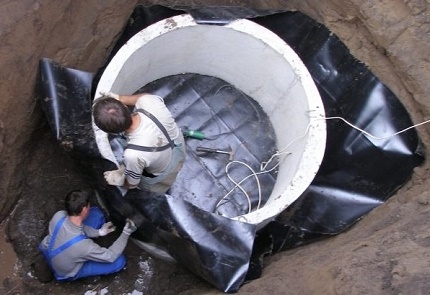
To fix the roll material on the surface of the rings, the walls are coated with tar or bitumen mastic, and then waterproofing is glued. One layer is not enough, it is practiced to make a layer of 3-4. At the end, take the mastic and apply it to the seams between the strips.
Stucco under pressure
For internal and external waterproofing, plaster is also used under pressure. Non-shrinking waterproof cement is supplied under high pressure created by compressed air. The sealing layer is uniform and dense.
The use of this method is not always justified due to considerable financial costs. For its implementation, it is necessary to have a special device, the so-called "cement gun." Work is carried out at a temperature of at least +5 degrees C, 2 layers are laid, the thickness of each is from 5 to 10 mm.
To apply the next layer, you have to wait until the previous one is fully grasped, and this sometimes takes up to 2 weeks. To prevent cracking of cement on a hot day, it is moistened every 3.5 hours. In cool weather, the interval is increased to 12 hours.
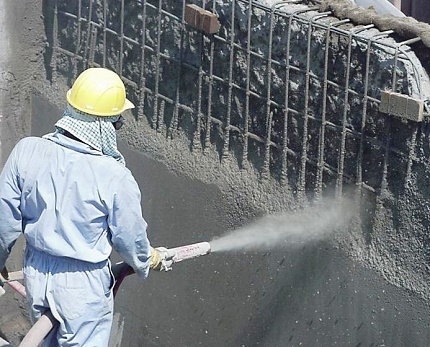
Penetrating or capillary waterproofing
This type of waterproofing is the most reliable. Materials, after application to the concrete surface, penetrate into the pores, crystallize, fill all the voids. The whiskers are embedded in the structure of concrete, clog microcracks and become one with his body. They do not impair the air permeability of the surface, but, compacting its structure, do not allow water to pass through.
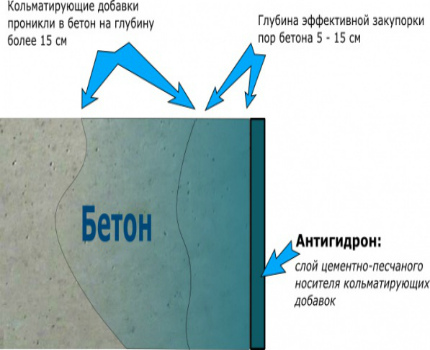
Crystalline hydrates do not decompose and are not washed out of concrete, therefore such protection of the septic tank lasts a long time. A layer on the surface of the rings only fixes, and for some time retains the active chemical components that play a major role in creating high-quality waterproofing of the structure.
Some manufacturers claim that once all chemical processes are complete, the layer can be removed.
The duration of crystallization and the penetration depth of the insulating material into the thickness of the concrete is affected by the degree of porosity and humidity of the septic tank rings. With high humidity parameters, crystals form faster, and when this indicator decreases, the process slows down. For concrete surfaces treated in this way, microcracks themselves are tightened.
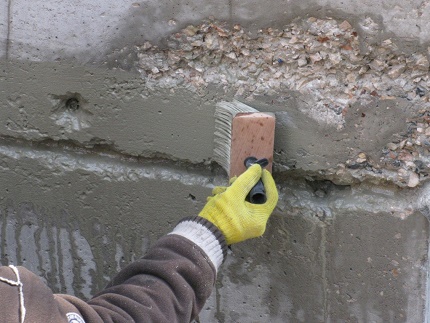
Penetrating waterproofing is preceded by a thorough surface treatment. It is completely cleaned using special chemical solutions or a mechanical method.
When the result is a flat surface, it is saturated with moisture, pouring water from a hose under high pressure. The active components of the waterproofing composition penetrate to the same depth as water.
Processing begins with seams. It is better to do this during the installation of rings. They are laid on a layer of cement mortar, then treated with a penetrating mixture. Next, apply the mixture on the entire surface, strictly following the manufacturer's instructions, otherwise the waterproofing layer will not meet the stated requirements.
The mixture is prepared in small parts. To mix it with water, an electric drill operating at low speeds and equipped with a spiral nozzle is used. The composition is applied to the surface of the rings using a spray, roller or paint brush. You need at least 2 layers with an application interval of 1.5 to 3.5 hours.
The second treatment begins when the first layer has not yet had time to dry completely. A coating with a total thickness of 1.5-2 mm should be obtained. It takes a lot of material - about 1 kg per 1 sq. Km. m
For penetrating waterproofing, the following compositions are used:
- "Lahti". Inexpensive dry mix made on the basis of cement.
- "Kalmatron." The composition includes Portland cement, sand, patented active reagents.
- "Hydro S". Waterproofing coating based on mineral raw materials.
- Penetron. A penetrating mixture that creates a barrier that prevents capillary suction of fluid.
If you treat the septic tank from the outside and inside, then in the end you will have a durable hermetic design with a uniform structure.
Materials for sealing inter-ring seams
The seams between the reinforced concrete rings are a weak link in the septic tank. Most often, the first leaks appear here. For this reason, their sealing is necessary. As an insulator, a reinforcing fabric, rubber tape seals, rubber gaskets with bentonite granules, polymer cement in combination with a jute or hemp rope are used.

In the first and second cases, the insulation is effective, but is expensive, and the reinforcing sheet must also be irradiated with ultraviolet light. Rubber gaskets are cheaper, they fill the gaps, creating a plastic layer. They are selected, focusing on the wall thickness of the concrete rings.
Penetrating waterproofing manufacturers produce auxiliary mixtures. They close up not only the seams between the rings, but also seal the pipe inlets, repair wide cracks. They also include high-quality cement, quartz sand of the finest fraction, chemically active additives. They are distinguished by excellent adhesion to concrete.
To close the seam or crack, along them with a grinder and a perforator, make a strob to a depth of 2.5-3 cm and to the same width. They clean it from dust, small particles, moisten it with water, apply a primer. When the primer is dry, fill the gate with an auxiliary composition. After the seam and part of the surface around it is treated with the main waterproofing mixture.
Among the additional materials there is a group designed to eliminate pressure leaks. They are characterized by quick setting and simultaneous expansion. Around the leaks, they simply clear the surface, then make a sample with a puncher resembling a “dovetail” shape.
A cork is formed from the mixture, with dimensions slightly exceeding the dimensions of the sample, it is pressed into the place of leakage with force, and held until fully seized.
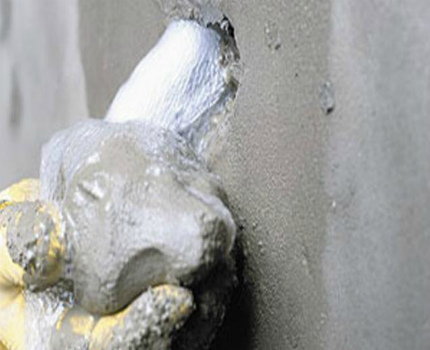
When the water stops flowing out, the cavity is primed with the basic composition, completely filled with additional solution, allowed to dry, moisturize. Next, a 2-layer coating is applied using a basic waterproofing mixture. Subject to technology, the likelihood of a re-occurrence of a leak is 0.
Popular excipients include:
- Waterplag. Water seal is used to eliminate a weak leak. Grasps for 3 minutes.
- Peneplag. The quick setting mixture stops the most intense flow in 40 seconds.
- Aquafix. Hydraulic plug, solidifying under the influence of moisture in a short time, therefore, it is well suited when it is necessary to eliminate the leak.
- Penecritus. Applied for sealing joints, places where pipes enter the septic tank.
- MEGACRET-40 - cement based repair composition with the inclusion of polymers. Suitable for sealing inter-annular joints, as well as for sealing cracks. It has excellent adhesion to the concrete surface, is easy to apply, does not shrink.
All manufacturers declare that their mixtures have a unique, patented composition. In fact, their characteristics, as well as methods for creating a protective layer, are approximately the same. The final result is affected by the fact that the surface and the waterproofing composition are so well prepared.
Conclusions and useful video on the topic
Here you will see how active leaks are eliminated:
Using any option of waterproofing a septic tank, remember that the guarantee of obtaining high-quality durable coating is accurate adherence to the technology. Do not neglect the recommendations of manufacturers regarding both the preparation of mixtures and their application.
Want to share a new tool or an effective method of sealing a septic tank? Do you have questions on the topic or found flaws in the material presented? Please write comments in the block below.

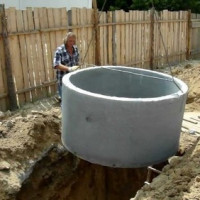 How to make a two-chamber septic tank from concrete rings: a building instruction
How to make a two-chamber septic tank from concrete rings: a building instruction 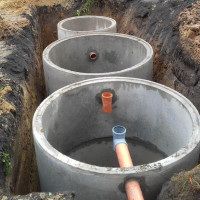 Septic tank made of concrete rings: device, schemes + step-by-step installation process
Septic tank made of concrete rings: device, schemes + step-by-step installation process  Overview of the septic tank “Sunrise”: characteristics, model range, installation rules
Overview of the septic tank “Sunrise”: characteristics, model range, installation rules 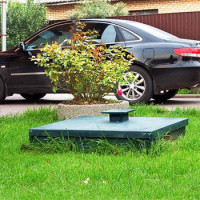 Overview of the septic tank for the cottage “Unilos Astra”: device, service rules, advantages and disadvantages
Overview of the septic tank for the cottage “Unilos Astra”: device, service rules, advantages and disadvantages  How to arrange a filtering field for a septic tank: typical schemes + design rules
How to arrange a filtering field for a septic tank: typical schemes + design rules 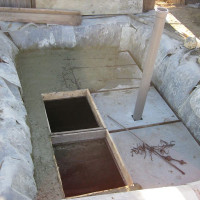 Do-it-yourself monolithic concrete septic tank: schemes and rules for arranging a concrete septic tank
Do-it-yourself monolithic concrete septic tank: schemes and rules for arranging a concrete septic tank  How much does it cost to connect gas to a private house: the price of organizing gas supply
How much does it cost to connect gas to a private house: the price of organizing gas supply  The best washing machines with dryer: model rating and customer tips
The best washing machines with dryer: model rating and customer tips  What is the color temperature of light and the nuances of choosing the temperature of the lamps to suit your needs
What is the color temperature of light and the nuances of choosing the temperature of the lamps to suit your needs  Replacement of a geyser in an apartment: replacement paperwork + basic norms and requirements
Replacement of a geyser in an apartment: replacement paperwork + basic norms and requirements
In our country house there is a simple sewer drive of three rings placed on top of each other. Before installing rings, the husband prepared the bases for them, then he smeared each ring both inside and out with mastic with latex. Then, after installation, I wrapped it with bitumen roofing material. After about half a meter in diameter from the rings, the whole foundation pit fell asleep with blue clay, he said that it would be more reliable.
I don’t know about “more reliable”, but the sewer capacity has been standing for 12 years and does not cause problems.